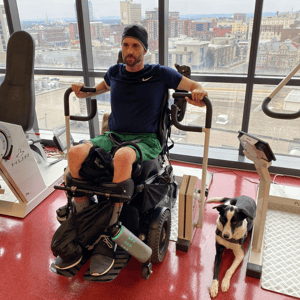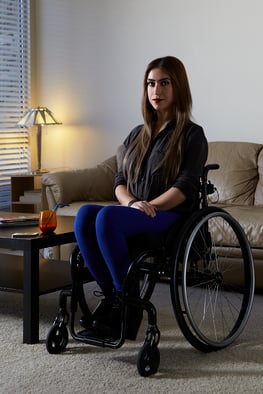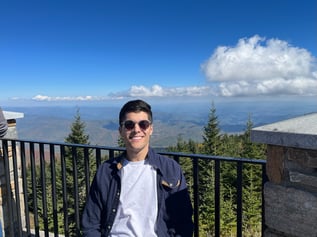Over the past two decades, scientists have made tremendous strides combining tools from neuroscience, engineering and cell biology to advance treatments for spinal cord injury (SCI). The work represents a seismic shift to the decades-old dogma that “nothing can be done for SCI patients.”
“Even 10 years ago, SCI treatment was a completely different conversation,” says Katie Sharify, Communications Team Coordinator at the California Institute for Regenerative Medicine (CIRM). “We’re on the path toward finding a cure. Maybe not in my lifetime, but sometime in the future, so when someone wakes up in the hospital after a spinal cord injury, they’ll already be on the road to recovery.”
With clinical trials exploring the safety and efficacy of technological advances, such as epidural stimulation, nerve regeneration and cell transplant therapies, patients around the globe have new hope for regaining their independence and improving quality of life. Here are three patient stories that inspire hope.
 Jerod Nieder
Jerod Nieder
In 2011, when Jerod Nieder was vacationing with his family in Mexico, he dove into the sandbar and broke his neck. The injury left Nieder, then 29, a quadriplegic. Despite the grim prognosis, Nieder set out on a mission to uncover treatments to help him regain mobility and joined, by lottery, a randomized clinical trial investigating whether epidural stimulation can produce functional improvements for SCI patients. It took four years to be accepted, and in October 2019, he underwent surgery to implant an epidural stimulator.
When doctors turned on the device two weeks post-surgery, Nieder started moving his leg. “That moment didn’t change everything, but it opened the door to possibility,” Nieder says.
From there, Nieder took the reins working tirelessly to keep up with occupational therapy, physical therapy and clinical appointments. With the help of the stimulator, he was soon able to lift his legs, sit up, stand—and walk. “But the stimulator’s greatest impact is on basic functions like blood pressure control,” Nieder says. “I have so much more energy.”
Today, Nieder hosts exercise classes called “Positively Fit After Paralysis,” where he teaches people who use wheelchairs how to build their cardiovascular fitness and muscle strength. Through his social media presence on the Instagram account, “Positively Paralyzed,” he’s also a beacon of hope for new patients showing them what’s possible after a devastating injury.
 Katie Sharify
Katie Sharify
Katie Sharify was driving from her home in Pleasanton, California back to school at the University of Southern California when she took her eyes off the road to steady the energy drinks that were rolling around on the passenger side floor. Her tires hit gravel, the airbag deployed and Sharify lost control of her vehicle.
The impact sent her careening through the back window. “When paramedics found me, I was 20-feet away from the car,” says Sharify, who was 23 at the time of the accident in 2011. She was paralyzed from the chest down due to an injury in the t3 and t4 vertebrae.
In the immediate aftermath of this life-changing traumatic experience, Sharify had a two-week window to decide whether to participate in the first human clinical trial testing the safety and efficacy of OPC1, an allogeneic oligodendrocyte progenitor cell transplant therapy.
Since pluripotent stem cells can transform into any other type of cell in the body, and replicate repeatedly, they hold tremendous promise for SCI. Before injecting the cells, scientists coax them to form the precursors of oligodendrocytes, a type of cell that forms myelin, the protective sheath that insulates our nerve fibers. Remarkably, these cells also encourage blood vessel formation and the secretion of growth factors that help nerves regenerate.
While she was still hospitalized, Sharify agreed to enroll in the clinical study evaluating OPC1, and within days, she received an injection of 2 million OPC1 cells. The low dose was designed to test for safety, so it wasn’t likely to help her directly. “I wanted to contribute to advancing the science, and also do my part to help regain my independence and mobility,” Sharify says.
OPC1 has now been tested in two clinical trials to date; a five-patient study in acute thoracic spinal cord injury, the study in which Katie participated, where all subjects were followed for at least 10 years, and a 25-patient study in subacute cervical spinal cord injury, where all subjects were evaluated for at least 2 years. The clinical development of OPC1 has been partially funded by a $14.3 million grant from the California Institute for Regenerative Medicine. Additional clinical trials investigating the efficacy of OPC1 are just beginning to get underway.
Through her involvement in the trial, Sharify became a vocal advocate for stem cell and cell transplant therapy research, working with CIRM, attending symposiums and sharing her experiences with a wider audience. She finished school, then a master’s program at the London School of Economics. Today, she has come full circle, working as a Communications Team Coordinator with CIRM. “This fight is so important, and I want to be part of it until the very end,” she says.


 Jerod Nieder
Jerod Nieder Katie Sharify
Katie Sharify